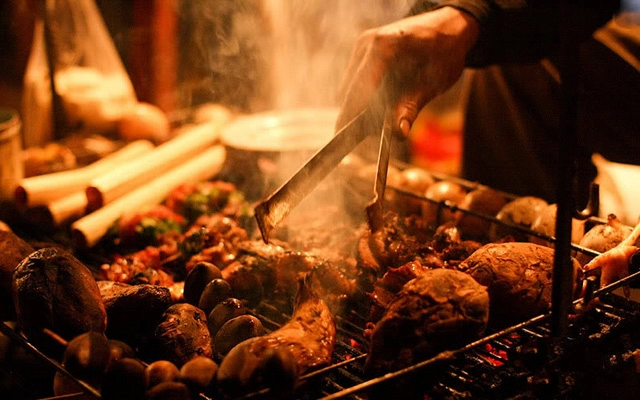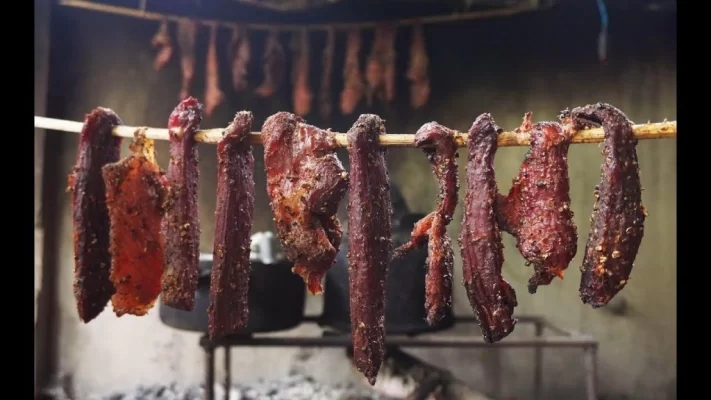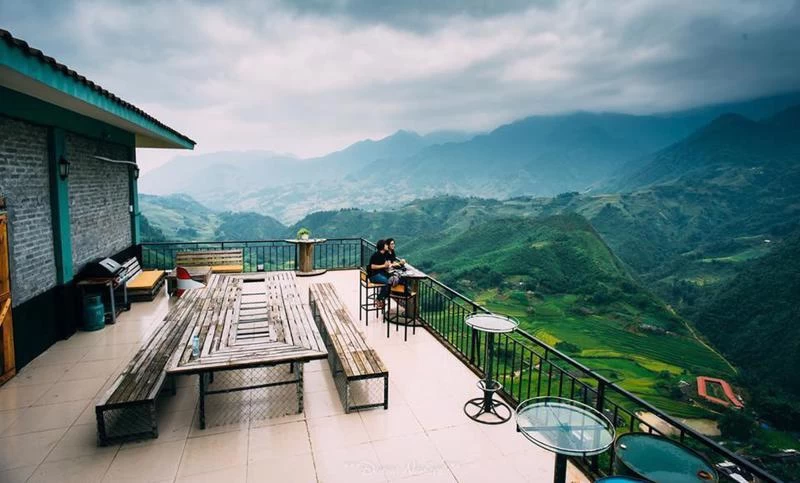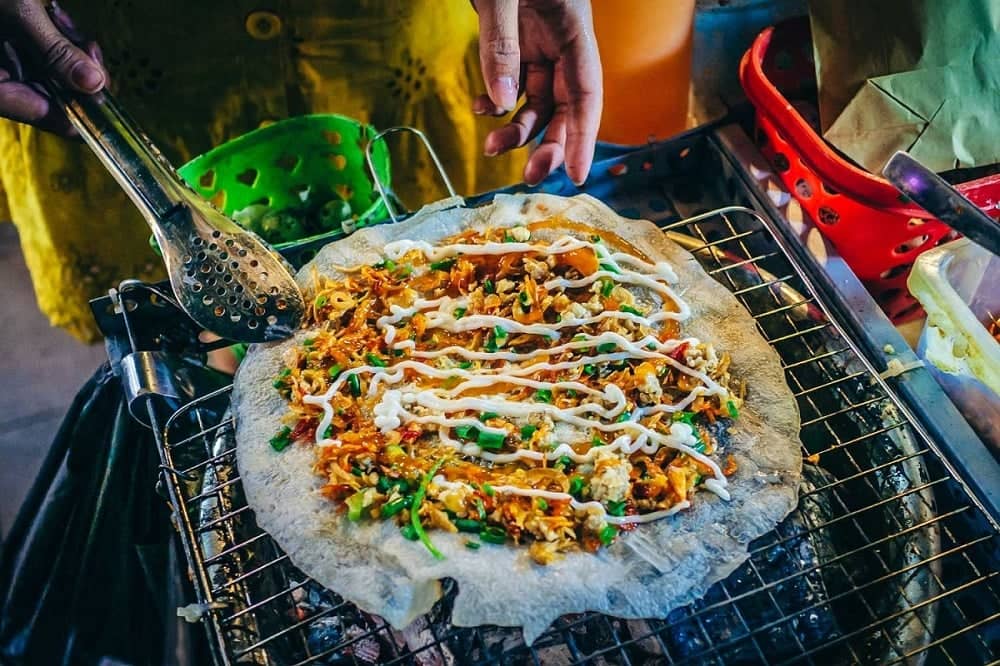
Sapa Cuisine
Sapa cuisine brings rich and diverse experiences through its distinct national identity and majestic natural scenery. With its unique geographical location and the influence of many different ethnic groups, Sapa cuisine shows a uniqueness and appeal that cannot be found anywhere else. Follow Ula Travel now!
1. Thang co (stewed horse meat and horse organs) in Sapa cuisine
Thang co, renowned for its unique name, is the quintessential specialty of Sapa cuisine that every visitor must experience. This dish is a harmonious blend of various ingredients, such as beef, buffalo meat, and horse offal, infused with an array of distinct spices.

Thang co (stewed horse meat and horse organs)
Rooted in the culinary tradition of the H’Mong ethnic group, Thang Co offers a distinct experience in Sapa cuisine. Its savory and slightly bitter flavor, derived from the horse’s bile, creates a delightful contrast. Particularly delightful amidst Sapa’s cold climate.
Crafting this dish requires the careful incorporation of twelve essential spices, including ginger, cardamom, lemongrass, and cinnamon. Thang co is simmered for hours to ensure the ingredients are tender and flavorsome, resulting in a truly satisfying meal.
Read more: Top 10 Best Restaurants in Sapa
2. Rainbow sticky rice
As a traditional dish often served on holidays or the first day of the seventh lunar month every year, rainbow sticky rice is the next culinary delight that tourists should indulge in when visiting Sapa. Decorated with seven eye-catching colors, this dish symbolizes the seven consecutive months of resistance of the Nung Din ethnic group.
Carrying a beautiful significance, rainbow sticky rice attracts many tourists to enjoy and explore its historical context. It’s not difficult to find this dish along the streets of Sapa, and once you taste it, you’ll experience the characteristic natural sweetness of the food.

Rainbow sticky rice
As you approach the plate of rainbow sticky rice, the delightful fragrance of rice and leaves wafts through the air. When enjoying this dish, you’ll notice the chewy texture of the evenly cooked grains and savor the essence of the Sapa cuisine—simple yet unforgettable. Typically served with grilled meat or sesame salt, those who have savored this delicacy never fail to shower it with praise.
3. Stove-guarded buffalo meat
Stove-guarded buffalo meat is one of the most famous specialties of Sapa cuisine. Stove-guarded buffalo meat is the signature dish of the Black Thai ethnic group, often enjoyed alongside a flavorful dipping sauce to elevate its aroma. This dish offers a variety of cooking methods, such as stewing, stir-frying, steaming, etc., promising a tantalizing and distinctive taste for both local and visiting food enthusiasts.

Stove-guarded buffalo meat
For indigenous locals, stove-guarded buffalo meat has long been an essential delicacy during festive gatherings. Meticulously prepared from ingredient selection to spice marination, the grilled buffalo meat emerges with enhanced texture, depth, and flavor. Crafting this special dish requires precision and finesse in cooking techniques to ensure the meat remains tender and succulent, avoiding any undesirable toughness.
Stove-guarded buffalo meat is typically cut into sizable chunks. To savor it, one would tear the meat into small pieces and dip them in the signature dipping sauce of the Northwest, gently experiencing the uniquely spicy and sweet flavors of Northwest buffalo meat.
Stove-guarded buffalo meat represents the deep cultural essence of the Northwest, from the imagery of the kitchen to the buffalo meat itself, all of which are distinctive elements rarely found elsewhere outside the Northwest region. If you ever find yourself in Sapa, be sure to indulge in this captivating dish of stove-guarded buffalo meat.
4. Sapa’s black chicken
Black chicken is a nutritious and flavorful dish in Sapa cuisine. The dishes made from black chicken in the mountainous region of Sapa have long been renowned far and wide. Therefore, if you visit Sapa but haven’t had the chance to taste Sapa’s black chicken, your trip is still incomplete.
Sapa’s black chicken is characterized by its small body size, with mature chickens weighing only about 1.2–1.5 kg, yet the meat is incredibly firm and flavorful. The distinctive feature of this breed is that its skin, meat, and bones are all uniformly black. Black chicken meat is low in fat and rich in nutrients, offering numerous health benefits such as enhancing vitality, nourishing the body, and improving cardiovascular health.

Sapa’s black chicken
The black chicken is a traditional dish among the H’Mong ethnic community. Sapa’s black chicken, in particular, holds significant medicinal properties and is often incorporated into various remedies to boost overall health, especially catering to the elderly and the ailing.
Apart from being utilized in medicinal soups with Chinese herbs, the black chicken is also esteemed in dishes like “grilled black chicken with honey” for its resilient skin, tender meat, and intense flavor profile. While there are diverse culinary preparations, black chicken dishes consistently offer distinctive hues, flavors, and health advantages, often eliciting admiration from tourists as they savor their consumption.
5. Vietnamese Apple Wine
When it comes to Sapa cuisine, one cannot overlook Vietnamese apple wine. Crafted from apples grown in the Northern Mountainous Region, this wine offers a unique blend of sweet and sour flavors, complemented by the slight bitterness of the cat apple, creating a distinctive beverage in the misty land.

Vietnamese Apple Wine
In the cold climate of Sapa, enjoying a glass of Vietnamese apple wine awakens all your senses. It delivers a burst of intense flavors, enticing aromas, and the characteristic amber hue of the drink, making it both visually appealing and delicious.
Renowned for its medicinal properties such as relieving headaches, dizziness, and insomnia, Vietnamese apple wine is a favorite among tourists, who often seek it out as a gift for family, friends, and loved ones. Alongside its exceptional cuisine, Vietnamese apple wine stands as a celebrated specialty in Sapa cuisine, encapsulating the essence of the mountainous region.
6. Van Salmon
Van salmon, a specialty of Sapa cuisine, typically inhabits cold-water streams. The flesh of marble salmon, characterized by its firm texture and appealing red hue, offers a delightful, mildly fatty flavor. Visitors here can savor dishes like Van salmon sashimi, mixed salads, grilled variations, and pepper-infused preparations. They shouldn’t overlook the marble salmon hotpot, known for its sweet-sour taste when paired with a selection of fresh Northwest vegetables.

Van Salmon
With a cool climate year-round and even cold winters with occasional snow, the quality and color of Van salmon rival any imported salmon in Vietnam. This fish features firm, succulent flesh without fat, boasting a fresh pink hue and a tender, buttery sweetness ideal for various dishes such as sashimi, fried, steamed, curry dishes, etc. However, its standout preparations include salmon hotpot, salmon salad, grilled salmon.
7. Khang Gai Dried Meat
Khang Gai dried meat, comprising horse, beef, buffalo, and pork, is meticulously cut and hung by the H’Mong people in their kitchens for prolonged preservation, sometimes lasting up to 3 years. This meat boasts a delightful, sweet, and crispy flavor profile.
Typically, it is taken down from its hanging spot, thoroughly washed, and cooked alongside various vegetables. Visitors are encouraged to pair Khang Gai dried meat with wine, as this duo represents a quintessential duo of Sapa cuisine, perfect for sharing with friends or presenting as gifts to loved ones.

Khang Gai Dried Meat
Due to extensive smoking, Khang Gai dried meat offers a rich, crispy, and irresistibly flavorful taste that immediately captivates travelers. It’s an ideal accompaniment for wine or a comforting treat during the cold winter days in Sapa. Despite lacking any seasoning, Khang Gai dried meat still boasts an enticing taste thanks to the natural sweetness of the meat. Upon tasting, one can also detect a subtle smokiness, enhancing its authentic Northwestern character. It evokes images of wisps of smoke drifting from humble, rustic rooftops.
Khang Gai dried meat has become a renowned delicacy in Sapa cuisine. When butchering large livestock such as buffalo, cow, horse, pig, etc., people often set aside the finest cuts to hang over the kitchen fire for slow drying. When visiting Sapa, Lao Cai, don’t miss out on trying this Khang Gai dried meat dish—you’ll be sure to remember its flavor.
8. Bitter bamboo shoot spring rolls
Bitter bamboo shoot spring rolls A renowned traditional delicacy of the Tày people in Sapa is the bitter bamboo shoot spring rolls. These rolls boast a delicate balance of flavors: a subtle bitterness from the bamboo shoots, complemented by the sweet aroma of chicken meat, shallots, and pepper, all encased in a crispy spring roll wrapper.
Every ingredient is meticulously selected and carefully prepared to craft a dish that delights both the palate and the eye. The unique and unmistakable taste of this specialty in Sapa cuisine is sure to captivate the hearts of many travelers who have the pleasure of savoring it.

Bitter bamboo shoot spring rolls
When eating, many cannot help but marvel at the deep forest flavors of the dish, combined with pleasant surprise at the crisp and crunchy texture that is gentle on the teeth, the slightly bitter taste of bamboo shoots, the rich sweetness of chicken meat, and the aromatic scent of various spices.
The bitter bamboo shoots grow with the bitterness of hardship, yet still possess a fragrant sweetness that serves as evidence of the beautiful love of the mountains. For this reason, the Tay people in the Northwest only make bitter bamboo shoot spring rolls during traditional village days. However, it has become more prevalent in meals nowadays to promote the Sapa cuisine to tourists.
9. Sour Salted Pork

Sour Salted Pork
Nestled within the heart of Sapa’s mountains is a dish that reminisces about traditional flavors and robustness: sour salted pork. Despite its simple preparation process, it exudes delicacy; fresh pork is boiled and then immersed in a special blend of wine, salt, and bay leaves. This soaking period spans from 2 to 3 weeks, resulting in the distinctive flavor of sour salted pork.
Upon tasting, one will encounter its characteristic salty and sour notes, coupled with the pork’s firm, crisp texture. This dish is ideal when paired with rice or served as an enticing appetizer.
10. Páu Plâu
Páu plâu is a delightful specialty in Sapa that appeals greatly to those with a sweet tooth. To create this elaborate dish, chefs meticulously select the roundest, firmest glutinous rice grains, which are then hand-ground into a smooth paste and sun-dried to the ideal texture. Páu plâu cakes often contain a tender, fluffy mung bean filling, either grilled or steamed, and are served with honey for a sweet and indulgent taste that is sure to leave a lasting impression.

Páu Plâu
Páu plâu is crafted from glutinous rice, which is soaked in lukewarm water for about 2 hours and then drained before being cooked into a sticky rice mixture. Once cooked and cooled, it’s ground into a smooth paste and shaped into cakes, ready to be consumed immediately.
Páu plâu can be preserved for up to 7 days. In contemporary times, Páu Plâu can be stored for approximately 2–3 months. They are flattened and coated with dry glutinous rice flour before being steamed or pan-fried, maintaining their softness and aroma. Handcrafted with care by locals, Páu plâu is a thoughtful gift for family, friends, and loved ones.
11. Mèn Mén
Mèn mén is a specialty only found in Sapa cuisine and the northern highland areas. Mèn mén is a Sapa specialty commonly found in the markets of the H’Mong people. Crafting this dish involves meticulously selecting the roundest and most robust maize kernels, which are then ground in traditional stone mortars and mixed with flour and a dash of water.
The corn mixture undergoes two rounds of steaming before being finely mashed. Each step in the preparation of mèn mén demands considerable knowledge and expertise, with processing techniques tailored to the specific ingredients used. Whether enjoyed with rice or mixed with noodles, mèn mén offers a delightful blend of fragrant and chewy textures characteristic of Northwest corn kernels.

Sapa’s Corn Mèn Mé
In the past, corn mèn mén served as the staple, the daily “rice,” for the H’Mong people. Today, despite the increased prosperity in the lives of the H’Mong, corn mèn mén remains a central component of their daily meals, even among families of means. This dish has become ingrained in their culture, nourishing generations of H’Mong descendants and remaining an essential part of holiday and festival celebrations.
Beyond its nutritional value, corn mèn mén holds profound cultural significance for the H’Mong people. Essentially, it is a simple dish of “steamed cornmeal.” However, its preparation requires considerable time, involving multiple steps and demanding expertise from the cook.
See more: Sapa travel tips




























